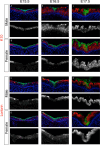This is a preprint.
Endoderm differentiates into a transient epidermis in the mouse perineum
- PMID: 39975347
- PMCID: PMC11838455
- DOI: 10.1101/2025.02.03.636156
Endoderm differentiates into a transient epidermis in the mouse perineum
Update in
-
Endoderm differentiates into a transient epidermis in the mouse perineum.Dev Dyn. 2025 Jun 25. doi: 10.1002/dvdy.70050. Online ahead of print. Dev Dyn. 2025. PMID: 40557929
Abstract
In eutherian mammals, the embryonic cloaca is partitioned into genitourinary and anorectal canals by the urorectal septum. At the caudal end of the mouse embryo, the urorectal septum contributes to the perineum, which separates the anus from the external genitalia. Growth of the urorectal septum displaces cloacal endoderm to the surface of the perineum, where it is incorporated into epidermis, an enigmatic fate for endodermal cells. Here we show that endodermal cells differentiate into true epidermis in the perineum, expressing basal, spinous, and granular cell markers. Endodermal epidermis is lost through terminal differentiation and desquamation postnatally, when it is replaced by ectoderm. Live imaging and single-cell tracking reveal that ectodermal cells move at a faster velocity in a lateral-to-medial direction, converging towards the narrow band of endoderm between the anus and external genitalia. Although the perineum is sexually dimorphic, similar spatiotemporal patterns of cell movement were observed in males and females. These results demonstrate that cloacal endoderm differentiates into a non-renewing, transient epidermis at the midline of the perineum. Differential movement of endodermal and ectodermal cells suggests that perineum epidermis develops by convergent extension. These findings provide a foundation for further studies of perineum development and of sex-specific epidermal phenotypes.
Conflict of interest statement
Competing Interests None
Figures




References
-
- Azzi L., El-Alfy M., Martel C., Labrie F., 2005. Gender differences in mouse skin morphology and specific effects of sex steroids and dehydroepiandrosterone. J Invest Dermatol 124, 22–27. - PubMed
-
- Chi L., Liu C., Gribonika I., Gschwend J., Corral D., Han S.-J., Lim A.I., Rivera C.A., Link V.M., Wells A.C., Bouladoux N., Collins N., Lima-Junior D.S., Enamorado M., Rehermann B., Laffont S., Guéry J.-C., Tussiwand R., Schneider C., Belkaid Y., 2024. Sexual dimorphism in skin immunity is mediated by an androgen-ILC2-dendritic cell axis. Science 384, eadk6200. - PMC - PubMed
-
- Clayton E., Doupe D.P., Klein A.M., Winton D.J., Simons B.D., Jones P.H., 2007. A single type of progenitor cell maintains normal epidermis. Nature 446, 185–189. - PubMed
Publication types
Grants and funding
LinkOut - more resources
Full Text Sources
